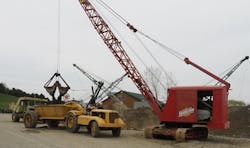The Moore Speedcrane and the Origin of Manitowoc Cranes
The Manitowoc Company is the only early-mid 1900s builder of cable excavators and cranes that survives on its own under American ownership while proudly carrying its own name on its products. Its earliest ancestor was Manitowoc Dry Dock Co., founded in 1902 by Charles West, Elias Grunnell, and Lynford E. Geer to build and repair Great Lakes ships. Renamed in 1910 to Manitowoc Shipbuilding Co., it gained a well-respected reputation for building all kinds of small to medium-sized ships, including car ferries and U. S. Coast Guard cutters. During World War I, Manitowoc built ocean-going freighters, first for British and Norwegian shipping lines and then the U. S. Emergency Shipping Board. Postwar work included manufacturing paper mill machinery and large industrial boilers, and servicing locomotives and railroad cars.
One could say West and Gunnell caught crane fever in 1916 when they observed cranes working at an aggregate plant in which they had purchased interest. They realized the potential for the crane industry, but they did not act on it until 1925 when they agreed to manufacture the Speedcrane, a new type of mobile crane invented by brothers Charles and Roy Moore.
The Moores had founded the Moore Speedcrane Co. in Fort Wayne, Indiana, to produce their invention, but constant design changes and poor marketing led to financial problems. Manitowoc took control of Speedcrane manufacturing and sales in 1927, paying royalties to the Moores until their patents ran out, and the Moores continued to work closely with Manitowoc on the development of new designs. This was Manitowoc’s start in the crane business, and the line would eventually become the Company’s sole business.
The first Speedcranes were steam-powered, traction-wheel machines of 15 tons lifting or 3/4-cubic-yard bucket capacity. Manitowoc built 10 of them. Steam was still popular, but internal combustion was gaining acceptance for its ease of maintenance and lower costs, so to meet the growing demand, the Moores redesigned the Speedcrane to allow for gas engine installation. The new model was called the 100.
By 1927, the 125 Speedcrane was introduced as a 1-1/4-yard crawler excavator or 20-ton crane with steam, gas, diesel, or electric power. It was well-conceived to operate from a simple, robust gear drive system with minimal parts in an oil bath, and the house and undercarriage were both of cast steel construction, replacing riveted fabrication. But just when business started to improve, the Great Depression struck. From 1929 through 1933, little product development took place. To survive, Manitowoc cut wages, staff, and costs; liquidated inventory; and only built cranes to order.
In 1932, two larger models were introduced, the 150 and 175 with 1-1/2- and 1-3/4-yard bucket and 26- and 32-ton crane capacity, respectively. These were the first models that were more than a mere reworking of the original Moore Speedcrane. Almost immediately after the introduction of the 150 and 175, the 125, 150, and 175 were redesignated the 1500, 3000A, and 3000B respectively, launching model nomenclature that is still largely used by Manitowoc crawler cranes today.
The Historical Construction Equipment Association (HCEA) is a 501(c)3 nonprofit organization dedicated to preserving the history of the construction, dredging and surface mining equipment industries. With over 3,600 members in twenty-five countries, our activities include publication of a quarterly educational magazine, Equipment Echoes, from which this article is adapted; operation of National Construction Equipment Museum and archives in Bowling Green, Ohio; and hosting an annual working exhibition of restored construction equipment. Our next International Convention and Old Equipment Exhibition will be September 22-24, 2023, at the National Construction Equipment Museum in Bowling Green, Ohio. The HCEA is raising funds for construction of a new purpose-built building to house its equipment collection, and the Convention will feature groundbreaking for it. Individual annual memberships in the HCEA are $35 within the USA and Canada, and $55 elsewhere. We seek to develop relationships in the equipment manufacturing industry, and we offer a college scholarship for engineering and construction management students. Information is available at www.hcea.net, or by calling 419.352.5616, or e-mailing [email protected].
About the Author
Tom Berry
Tom Berry is archivist for the Historical Construction Equipment Association (HCEA). Information is available at www.hcea. net, or by calling 419.352.5616 or e-mailing [email protected].
